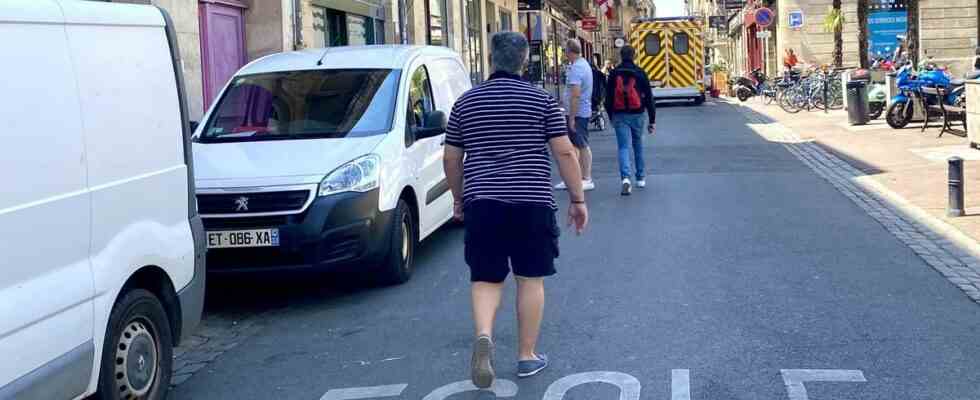Thanks to the ecological emergency and its health benefits, walking is back in the spotlight. So much so that the metropolis of Bordeaux integrated it into its scheme of mobilities. Walking is once again becoming an essential part of daily travel.
To go further in its development, the A’Urba, Bordeaux Aquitaine urban planning agencyis organizing a public meeting this Wednesday with various actors to discuss the policies to be implemented. 20 minutes questioned the director of A’Urba, Jean-Marc Offner.
The metropolis has included walking in its mobility plan. Will this mode of travel be taken into account more in the coming years?
Walking is the stem cell of mobility, because whatever mode of transport we take, we are always at one time or another a pedestrian. With the metropolitan plan on the march, and the will of some mayors, we actually have a shudder. The city of Bouscat, for example, has a global project around walking, which highlights the taste for public space, to rediscover that of social ties, damaged by confinement. But let’s stay modest, because walking has been regularly coming back to the fore for a few decades, and then it disappears from the radar.
Why ?
The banality of the subject: everyone is a pedestrian, and this is an area that falls to road managers, while public action likes visible things, major projects and ribbons to be cut. Perhaps a tactic would be to inaugurate from time to time a super pedestrian crossing, a footbridge, what do I know… Secondly, we forget a little about the urbanity that makes the city, and the cities concentrate their efforts on the somewhat prestigious spaces, forgetting the public space of everyday life, of the crowd, which is not always considered very positive. And finally, there is the competition of the bicycle in the ideological totems of the moment.
But, even if the subject has not succeeded in imposing itself in recent years, don’t you think that the era is still more favorable to pedestrians?
The time is more favourable, and putting it on the political agenda is very good. I was impatiently awaiting this metropolitan plan, but are we not mistaken in the way of doing it? I’m thinking of the extension of the central pedestrian areas, we see it in Bordeaux as in other cities, it’s good but it still favors extraordinary public spaces. We are not in the ordinary pedestrian who has home-to-work or neighborhood journeys to make. It is in Paris that we walk the most, because the city lends itself to it, but we are not going to transform the entire Bordeaux metropolis into a Haussmannian Paris, so the real challenge is to offer “walkability” conditions. for less urban areas, by working in a light way on the public space, by favoring itineraries, including in this peri-urban area where there is both little walking and little cycling. You have to wrestle with the street and the sidewalk of everyday life, even if it’s less of a seller.
In addition, we are not talking about very heavy adjustments to make, generally?
No, it is a bit of signage to redevelop preferred routes, a hierarchy of roads for pedestrians, vegetation. We have to take this sidewalk business head-on, it’s a real subject, especially in Bordeaux which has a very constrained road network. You have to make pedestrians want to, including in streets where there is not necessarily any commercial activity. Look at what we have done for cyclists, we could quite imagine that we also make corridors for pedestrians. The pedestrian condition suffers a little from the promotion of cycling, and there are a lot of cities where cycling is prohibited in pedestrian zones, it is a measure that seems obvious, because the coexistence of bicycles and pedestrians is not self-evident.
There is also the issue of schools, increasingly taken into account, right?
Yes, and initiatives have already been taken on this for several years, I am thinking in particular of the “At school without a car” approach, because it is clear that if we manage to get children off the motorized accompaniment by parents, we win on many fronts. Today, “Streets to schools” are developing, in Bordeaux as elsewhere. But it is often the forecourt in front of the school that is pedestrianized, not the schoolboy’s path… We know how to pedestrianize a small square, it’s easy, but we sometimes forget that the pedestrian is not just an occupant sedentary of the public space, it is someone who has itineraries.
What are the model cities for pedestrians today?
For me, the famous cities on a human scale that we talk about so often, are the cities made for pedestrians. It’s not a question of big or small town. Paris is a city made for pedestrians, New York too: the pedestrian is king in Manhattan, even if there are skyscrapers, because the articulation between the towers and the street has been very well thought out. In Bordeaux, competition from the car is felt quite quickly, even on short journeys.

